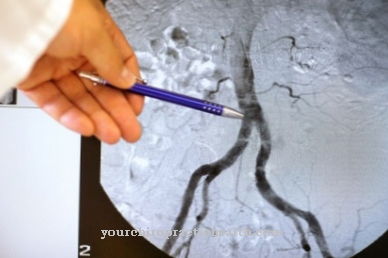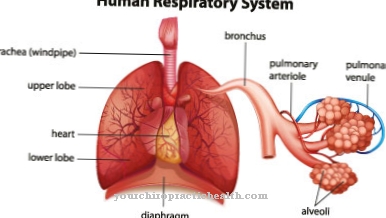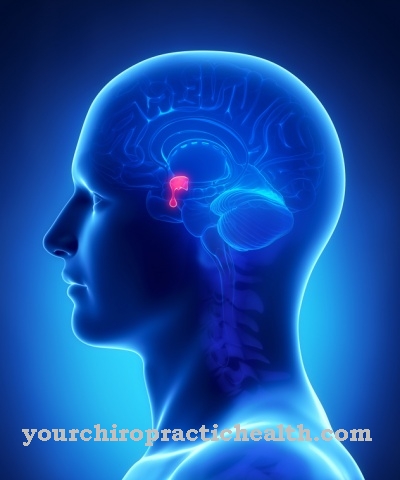As Lennox-Gastaut syndrome is a rare epilepsy syndrome. The difficult-to-treat form of epilepsy mainly affects children between the ages of 2 and 6.
What is Lennox-Gastaut Syndrome?

© luaeva - stock.adobe.com
Lennox-Gastaut syndrome (LGS) is the name of a severe form of epilepsy. It will also Lennox syndrome called and is considered difficult to treat. The disease particularly affects children between the ages of two and six, who suffer from frequent epileptic seizures.
Lennox-Gastaut syndrome was named after the American neurologist William G. Lennox (1884-1960) and the French doctor Henri Gastaut (1915-1995). Both doctors described the disease in detail for the first time in the 1950s and dealt with its research. In doing so, they distinguished the condition from other forms of epilepsy.
It is believed that out of 100 children who are affected by epilepsy, five will develop Lennox-Gastaut syndrome. Boys suffer from LGS more often than girls. Some of the children did not show any abnormalities before the onset of the disease. Others suffered from epilepsy beforehand, which then turned into LGS.
causes
There is no single cause for Lennox-Gastaut syndrome, so different reasons for its outbreak can be considered. One in five children will have West syndrome, another severe form of epilepsy, before they develop LGS. It is not uncommon for newborn children to experience convulsions or generalized epileptic seizures in advance.
In around two thirds of all affected children, Lennox-Gastaut syndrome is caused by damage to the brain. Other diseases or developmental disorders can also be responsible for the LGS. The most common triggers include metabolic diseases, tuberous sclerosis, toxoplasmosis, meningitis (meningitis) or encephalitis (inflammation of the brain).
Other causes include pronounced organic brain disorders due to a lack of oxygen during the birth process or a premature birth as well as various traumatic brain injuries. In many cases, Lennox-Gastaut syndrome does not have any underlying underlying disease. In medicine, one speaks of an idiopathic or cryptogenic LGS.
Symptoms, ailments & signs
The Lennox-Gastaut syndrome usually appears between the ages of 2 and 6. Sometimes the outbreak only occurs after the age of 8. Since there are considerable parallels to the West Syndrome, a relationship between the two diseases is assumed.
A typical symptom of Lennox-Gastaut syndrome is the repeated occurrence of epileptic seizures, which show up several times a day. Different types of seizures are characteristic, the diversity of which cannot be observed in any other epilepsy syndrome. The children affected most often suffer from tonic seizures, which they usually show during sleep and are accompanied by stiffening of the muscles.
When tired, myoclonic seizures often occur, with sudden onset of muscle twitching. Further complaints of the LGS are atonic seizures, grand mal seizures, focal and tonic-clonic seizures as well as atypical absences. Usually the seizures only last a few seconds.
Some children also suffer from apathy, unresponsiveness, and confusion. Another problem is falls due to epileptic seizures, which in turn can lead to injuries. For this reason, the affected children are advised to wear a crash helmet. Another side effect of Lennox-Gastaut syndrome are cognitive disabilities, behavioral problems and delays in the overall development of the body.
Diagnosis & course of disease
Diagnosing Lennox-Gastaut syndrome is considered difficult. The symptoms often show similarities to other diseases. In addition, there is no single cause of the syndrome. In order to be able to differentiate the LGS from other epilepsy syndromes, the examining doctor clarifies the age of the child when the symptoms first appear.
He is also concerned with the clinical picture, the frequency and diversity of epileptic seizures and possible delays in physical and psychological development. A sleep EEG is an important diagnostic method. The typical tonic seizures usually show up during sleep.
A differential diagnosis of the so-called pseudo-Lennox syndrome, in which the tonic seizures are absent, is also important. Magnetic resonance imaging (MRI) of the brain can be performed to find out organic brain triggers. If the movement patterns of the epileptic seizures appear predominantly on a certain side of the brain, this indicates their damage.
Because Lennox-Gastaut syndrome is difficult to treat, the disease rarely develops positively. The LGS ends fatally in around five percent of all cases. Often neurological deficits also occur, which cause delays in the child's mental development.
Complications
As a rule, patients with Lennox-Gastaut syndrome suffer more from epileptic seizures. These can significantly reduce and restrict the quality of life of the person affected. In most cases, the seizures also lead to severe pain and further restrictions in everyday life. Relatives and parents are also often affected by Lennox-Gastaut syndrome due to psychological complaints or depression.
The patients also suffer from pronounced fatigue and not infrequently from muscle twitching. There is also an adeptness, so that those affected can end up with disorders of coordination and concentration. The development of children is often severely restricted and delayed as a result. In most cases, Lennox-Gastaut syndrome also leads to behavioral problems and other disabilities for the patient.
Motor and cognitive abilities are not infrequently disturbed by Lennox-Gastaut syndrome. As a result, those affected can also suffer from teasing or bullying in childhood. Lennox-Gastaut syndrome is treated with the help of drugs. As a rule, there are no particular complications. However, in most cases there is no completely positive course of the disease.
When should you go to the doctor?
If the child suddenly has convulsions or persistent fatigue, this indicates a serious condition that needs clarification. Parents of affected children should discuss the complaints with their pediatrician. If the symptoms persist, the child must be examined and, if necessary, treated with medication. If there are behavioral problems or signs of cognitive disability, it is best to also consult a doctor so that a diagnosis can be made quickly. If Lennox-Gastaut syndrome is present, the child must be closely monitored.
If there is no or inadequate treatment, the epileptic seizures can lead to falls and other complications. In addition, the suffering often has a negative impact on the child's mental state. Therapeutic treatment lowers the risk of serious mental illness. The drug treatment is supported by physiotherapeutic measures. In severe cases, surgery must be performed to avoid major discomfort. Since the Lennox-Gastaut syndrome can develop very differently, a medical examination is always necessary.
Treatment & Therapy
Compared to other forms of epilepsy, Lennox-Gastaut syndrome is difficult to treat. However, treatment is still considered easier than for West syndrome. However, the success of the treatment cannot be guaranteed even with an early diagnosis.
Most people who get sick are given medication to control the seizures. Active ingredients such as valproate, felbamate, benzodiazepines, topiramate, levetiracetam and lamotrigine are used. One problem, however, is that the drugs cannot always guarantee freedom from seizures.
In treatment-resistant epilepsy, following a ketogenic diet is considered useful. The protein-balanced and carbohydrate-limited diet led to an improvement in the symptoms in one of three cases of illness.
If a treatable organ lesion is responsible for the Lennox-Gastaut syndrome, there is the option of surgical intervention as part of epilepsy surgery. Thus, with the surgical removal of the damage, the seizures can be remedied.
Outlook & forecast
The prognosis for Lennox-Gastaut syndrome is poor. There is irreparable damage to the brain. This significantly affects the patient's quality of life. Without medical care, life-threatening conditions can arise. The epileptic seizures must be monitored and controlled by a doctor to reduce the risk of complications. One treatment tries to minimize the occurrence of seizures by administering medicines. If the given active ingredients are well absorbed and processed by the organism, overall a favorable course of the disease can be achieved.
Nevertheless, the drugs have side effects. In addition, a seizure can occur again at any time over the life span. Freedom from complaints is not guaranteed. Surgery can be performed on some patients. Surgery is also associated with risks and side effects. Nevertheless, for some sufferers this treatment measure is a good option for long-term relief from the symptoms.
In a surgical procedure, the damaged areas of the brain are removed. If there are no further complications, the person affected experiences a significant improvement in their general health. However, it must be taken into account that it is a highly complex intervention in the human brain. If surrounding regions are damaged in the process, severe irreversible functional disorders can occur in the organism.
prevention
There are no known preventive measures against Lennox-Gastaut syndrome. There is no uniform cause for the occurrence of epileptic seizures.
Aftercare
Since Lennox-Gastaut syndrome is incurable, regular and comprehensive follow-up care is required. Those affected usually suffer from a number of complications and complaints, which in the worst case can lead to the death of the person concerned. The disease should therefore be recognized and treated very early so that there are no further complaints or complications.
Sufferers should see a doctor regularly to review medication settings and possible side effects. Psychological support for relatives can also be recommended. In addition, relatives should be trained to recognize an epileptic seizure and take appropriate action. In the event of a cramp, the emergency doctor should be called immediately, as this can be life-threatening.
You can do that yourself
Lennox-Gastaut syndrome is associated with epileptic seizures and often shows up even in small children, so that the custodians bear the greatest responsibility for appropriate medical care and patient care. First, the parents regularly accompany the sick child to medical examinations. In addition, the custodians learn first aid measures and how to deal with children correctly in the event of epileptic seizures.
As these occur to a very high degree, small children are exposed to an increased risk of accidents. It is therefore advisable for patients to wear a helmet to protect their head from serious injuries. In severe cases, the parents also equip the child with joint protectors, for example on the knees or hands.
The epileptic seizures significantly limit the well-being of the sick. In addition, the children also suffer from impaired cognitive development, so that attendance at special care facilities is often essential. Later, the patients usually attend a special school in order to develop them according to their individual perception. In addition, social contacts with other children often have a beneficial effect on the patient's quality of life. Since the parents are exposed to enormous stress from the sick child and his or her epileptic seizures, they often develop depression, which is always in need of therapy.
























.jpg)



